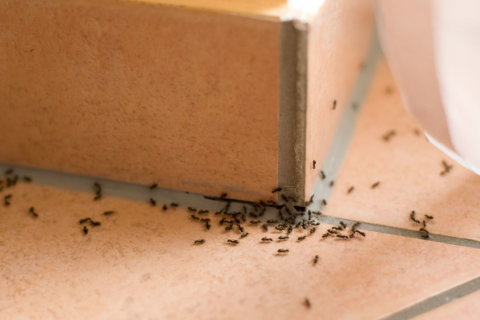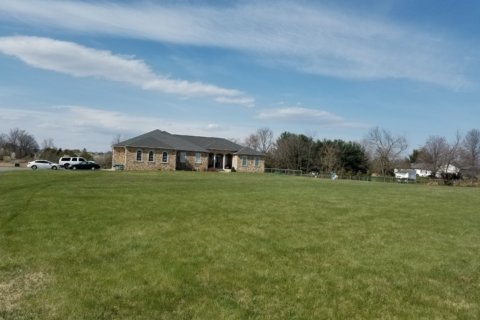Meet Mike Saturday in Maryland! Mike will appear at 11 a.m., 1 p.m. and 3 p.m. April 28, during the Calvert County Home Show, at the Fairgrounds in Prince Frederick. See details here.
Friday is Arbor Day — a good time for me to remind everyone of the basic rules of tree planting (which, based on all the volcano-mulched nightmares out there, no one seems to actually know).
Planting
- Pick an area that drains well and is far enough away from the house to allow for the full final size of the tree — especially evergreens, whose “skirts” can grow surprisingly wide.
- Dig a wide hole, not a deep one.
- When you dig, stay away from water and waste pipes, as well as [or especially] underground power lines. “Call 811 before you dig.”
- If the tree is “balled and burlaped,” remove any and all wrappings from the rootball and place the tree in the hole.
- If the tree is in a pot, take it out, rough up the soil around the roots and place the tree in the hole.
- Either way, if the root flare is below the soil line, take the tree out, add some dirt back into the hole and try again. Make sure the final result does not look like a lollipop.
- Fill the hole back up with soil you removed. Do not improve the soil in the hole.
- Tamp down the soil and water by letting a hose drip at the base of the plant for 12 to 24 hours.
Mulching
- First, you do not have to mulch. Look at the nicest, oldest trees in your neighborhood. No mulch, right?
- Even firster first: Avoid dyed-wood mulch entirely. Those colorings could be disguising the fact that your mulch is at least partially composed of chipped-up, insecticide-soaked pallets; treated wood; and construction and hurricane debris.
- Second, no mulch should ever be laid deeper than 2 inches, or rain will not be able to get through to the roots.
- And finally, no mulch should ever touch the trunk of a tree or the bark will rot, and the tree will suffer a premature death. Volcano mulching kills trees. Period.
A good use for crappy wood mulch
Paula in Indian Head, Maryland, writes: “My lawn guy does not like to weed-whack along my fence line because it uses too much string in his trimmer, but I hate the unkempt look of the sprouting grass and weeds. Is there a nontoxic grass and weed killer, safe for pets and birds, that I can buy or make at home?”
Yes to “buy”; no to “make at home,” Paula. But any “weed killer” is going to require constant reapplication in such an area. Your situation is the perfect use for wood mulch.
One last whack down and then 2 inches of mulch every season should keep the area looking neat. You can even use the junky wood mulch I always warn against in this specific situation. (As long as it isn’t close to vinyl siding or a light-colored car.)
Non-union carpenter bees
Juliana in Vienna writes: “Carpenter bees are nesting in some untreated wood I have stored under my porch. Should I try to move the wood to another location and let them use it since you said they are good for environment?”
Depends on whether you intend to actually use the wood for something sometime soon, Jules. You said in your email that the porch itself is made of Trex, a composite plastic and wood waste-based “lumber” that does not appeal to carpenter bees, so that’s not an issue.
If you want to save the wood, stain it with almond oil, which repels carpenter bees. (Buy it in bulk from a place that sells supplies for massage therapists; they use it by the gallon.)
Then get some cheap redwood or spruce, drill starter holes in the wood (about 2 inches in, using a 5/8” drill bit) and hang it in a shady spot near the house. With any luck, the bees (which, yes, are great pollinators — and don’t sting) will move from the wood you want to the new nests you have provided, especially if you used almond oil on the old wood.
A better boric acid bait for ants
Richard in Burke, Virginia, had a question about ants a few weeks back and now writes that his boric acid bait traps are old and opened. Should he replace them?
Absolutely, Richard. If you depend on outdated and opened material, the ants will start receiving mail at your place. And when you buy your fresh traps, consider ones recently introduced by the Terro company.
These traps contain the same boric acid active ingredient as before but now incorporate two different baits: one to attract ants that want protein, and one for ants that want something sweet.
Oh, and the traps are effective against roaches as well.
Mike McGrath was Editor-in-Chief of ORGANIC GARDENING magazine from 1990 through 1997. He has been the host of the nationally syndicated Public Radio show “You Bet Your Garden” since 1998 and Garden Editor for WTOP since 1999. Send him your garden or pest control questions at MikeMcG@PTD.net.







